Your Guide on How Many Keywords Should You Use for SEO
If you’re wondering how many keywords should I use for SEO, this one is for you! As more and more website owners and content creators strive to maximize their online visibility, finding the right balance of keywords has become a crucial factor in driving organic traffic and boosting search engine rankings.
Keywords are important because they represent the bridge between what people search for and the content you provide. Ensuring your content aligns with their search queries, you help connect the right searchers with valuable information or solutions.
Moreover, more than half (53%) of the total website traffic comes from organic sources, indicating the significant impact of natural search on driving visitors to a site.
So, let’s get into the details and answer the most asked question of how many times a keyword should be used in SEO.
How Many Keywords Should I Use for SEO?
With countless opinions and debate lords saturating the Internet (and in the end, it’s not absurd that it happens this way because Google doesn’t indicate anything specifically), we have curated insights from renowned SEO specialists and incorporated the perspective of a reputable company in the field.
By examining and synthesizing their viewpoints, we aim to present you with a well-rounded understanding of this topic. After their opinions, we will draw from our experience and expertise to provide our perspective and answer the burning question.
1. Rand Fishkin’s Outlook | The Founder of Moz and SparkToro

Rand Fishkin is a real OG for dishing out opinions on SEO. He is the founder of Moz and SparkToro and an SEO expert with 20 years of experience. He is a go-to source for learning about all things SEO and, with his insights and expertise, a trusted authority in the industry.
Rand’s voice stands out regarding the number of keywords to use in SEO.
He recommends identifying a primary keyword with low competition and high traffic that can be applied in various contexts. Then, based on the article’s length, target audience, and specific topic, select relevant secondary keywords.
According to Rand Fishkin, when it comes to using keywords on web pages, there are some key recommendations to keep in mind. For about 95% of pages, he suggests following these guidelines:
- Include the target keyword (or primary keyword) in the page’s title element to indicate its relevance.
- Incorporate the keyword in the headline, ensuring it appears prominently at the top of the page. This helps provide consistency and reassures searchers they’ve clicked on the right result.
- Include the keyword once in the meta description, as it can help make the snippet more appealing and relevant to searchers.
- Aim to include the keyword two to three times within the content unless the page is highly visual or interactive with minimal text.
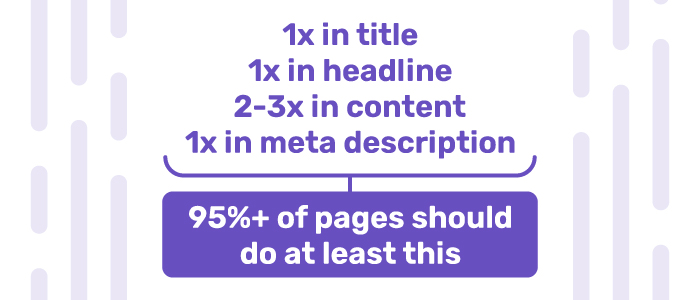
It’s also important to consider secondary aspects such as image optimization, including keywords in image alt attributes and file names.
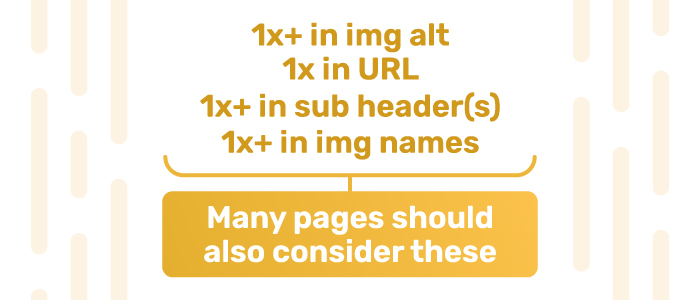
He also emphasizes using keywords in the URL and subheaders but cautions against going overboard and keyword stuffing.
Rand highlights the search engines’ use of stemming, which reduces the need for repetitive keyword variations.

The key takeaway is to use keywords strategically and avoid excessive repetition that can negatively impact both searchers and search engine algorithms.
2. Neil Patel’s Position | The Founder of Neil Patel Digital

In my circle, there’s this unwritten rule: if you don’t know who Neil Patel is, you’re not a legit marketer. And let me tell you, there’s some truth to it. When you dive into marketing, especially SEO, you can’t escape Neil Patel. He’s everywhere, dropping knowledge bombs left and right on the Internet.
Neil Patel is a total rockstar in the marketing world. He has founded businesses like NP Digital, Hello Bar, and Crazy Egg. He’s an entrepreneur, investor, SEO expert, and influencer. Forbes recognizes him as one of the top 10 marketers worldwide. He also made it to the top 100 entrepreneurs under 30.
Neil Patel knows SEO, so his opinion should be considered. Here are some guidelines based on Patel’s view on how many keywords you should use.
- Neil Patel emphasizes using one primary keyword, or a maximum of two that are used equally, and around them, build a network of several other secondary keywords relevant to the topic.
- He highlights that while SEO still matters to some extent, the focus should be on keyword placement rather than frequency.
- It remains crucial for the long-tail keyword to appear in strategic elements such as the page title, URL, subheaders, image descriptions, and meta descriptions.
- The outdated practice of repeating a keyword at least seven times in the body copy is no longer effective. It can negatively impact the quality and readability of the content.
- The focus should also be on using long-tail keywords. Neil points out that, especially with these keywords, only 3-4 are enough to create good content that ranks well.
The Point of View of Matt Cutts | Former Admin of the United States Digital Service

Matt Cutts is an important figure in SEO. He was the administrator of the United States Digital Service and the former head of Google’s Webspam Team. He is renowned as an American software engineer for providing valuable SEO tips and tricks.
Analyzing Matt Cutts’ work, we spotted a clip from an older video in which he discusses the number of keywords you should use in SEO, directly referring to keyword density.
- There is no magic number for keyword density that will help you rank higher.
- The first few times you use a keyword, Google recognizes the topic of your content, but using the keyword excessively doesn’t provide much additional value.
- Consider that Google’s Hummingbird update in 2013 expanded how keywords are understood. Instead of solely relying on specific keyword usage, Google now looks at the overall context of the page and user search behavior to determine the topic.
- You can effectively convey your topic through various related words and phrases.
However, even considering Matt Cutts’ insights from 2011, it becomes clear that we should focus on selecting 2-4 keywords relevant to our content. Still, it’s important to strike the right balance and avoid keyword stuffing, ensuring that the keywords are naturally integrated within the content.
The Standpoint of Ahrefs

In addition to the insights from esteemed individuals in the field, it is crucial to seek the perspective of a highly regarded industry authority – Ahrefs.
Ahrefs is a comprehensive SEO software suite incorporating many tools to enhance businesses’ online presence. It encompasses invaluable resources for link building, keyword research, competitor analysis, rank tracking, and site audits. It is primarily tailored for marketing professionals to help them provide extensive features to optimize marketing strategies effectively.
Regarding the keyword density emphasis, Ahrefs experts recommend picking only one primary and sufficient secondary keyword to cover an assigned topic fully.
You’re wondering why stick to just one primary keyword, right? Well, the Ahrefs experts have some solid reasons for us:
- Every page needs a clear-cut topic.
- Google has excellent skills at catching similar variations and spelling slip-ups.
- Optimizing for one keyword can help you rank for many other keywords.
But hold up because it’s not just about the primary keywords. It would be best to have those secondary keywords to cover a topic like a boss.
According to the Ahrefs experts, diving into related subtopics is key to fully exploring a subject, and secondary keywords help you do just that.
Here’s an example they throw down: Picture Google as a massive bookstore. So, imagine you stroll in, looking for the ultimate beginner’s guide to gardening. Wouldn’t it be dope if the store assistant hooks you with a guide that breaks down the basics in simple terms and satisfies other peeps? You wouldn’t even need to think about checking out other guides.
That’s how Google rolls, in a nutshell. The search engine tries to understand what you’re after and delivers the most helpful results while keeping some options low.
Our Perspective
The subject of how many keywords to use for SEO is controversial, with varying opinions from experts in the field. While there are no set rules or magic numbers, it’s important to approach keyword usage with flexibility and adaptability.
- Google’s official guidelines do not require a specific keyword limit or density. Instead, they emphasize the need for high-quality, relevant, and user-focused content. Rather than obsessing over keyword frequency, the focus should be creating valuable content that meets users’ search intent.
- Here’s the deal regarding nailing down an exact number of keywords to use in SEO. While it’s a tough nut to crack, we have a recommendation that might hit the sweet spot for you.
- Thus, we suggest focusing on 1 to 2 primary keywords that ideally double as long-tail.
- Sprinkle in 2 to 3 secondary keywords that complement and support your primary keywords. Incorporating relevant secondary keywords and synonyms can help provide more comprehensive coverage of your topic.
- It’s crucial to balance using keywords naturally and integrating them into the different elements of your web page, such as titles, headings, meta descriptions, and content. Keyword placement should feel organic and enhance the user experience.
This approach aligns with Google’s evolving algorithms, which now consider contextual relevance and semantic understanding to determine the content’s topic.
However, don’t just get caught up in the keywords part. It’s also essential to address other technical aspects of SEO beyond keywords. This includes optimizing site speed, improving mobile-friendliness, enhancing user engagement, and ensuring a strong website structure.
Last but not least, the best strategy is to be data-driven and monitor the performance of your content. Test different variations of keyword usage and analyze the results to understand what works best for your audience and industry.
How Many Keywords Are Needed to Rank?
A single page has the potential to rank multiple keywords, spanning thousands of search queries. The number of keywords a page can rank for depends on the level of SEO optimization and the overall search volume related to the topic.
Typically, the top-ranking page tends to secure rankings for around 1,000 relevant keywords, whereas lower-ranking pages may rank for fewer keywords.
Our answer is based on three important studies.

Source: Ahrefs
First, the Ahrefs study shows that, on average, a top-ranking page secures the #1 position for its target keyword and appears in the top 10 search results for nearly 1,000 other relevant keywords. The median value for additional keywords is approximately 400, more than twice as small as the average.
In another SEO case study conducted by Shane Barker, they successfully achieved first-page rankings on Google for over 1,800 keywords within only six months. This study highlights the effectiveness of optimizing and utilizing the TF-IDF formula (but not only). This formula allows us to assess the frequency of a keyword’s appearance in an article compared to its average usage across other web articles.
Besides all these, another study found that the key factors influencing higher rankings are keyword density and the relevance of highly searched terms. In other words, search engines prioritize the alignment between user search queries and the content’s relevance rather than focusing solely on the frequency of keywords.
Based on our analysis of these studies, we have drawn the following conclusions that align with what you would likely discover when reviewing them:
The ability to rank for over 1,000 keywords with just a single page comes from a well-optimized page attracting hundreds to thousands of related keywords, known as long-tail keywords. This remarkable breadth of rankings hinges on how the content is crafted and how effectively the page is optimized for other relevant keywords.
The potential to capture a wide range of keyword rankings is within reach, provided the content is carefully written and the page is optimized to target and resonate with numerous related search queries.
Should I Use the Same Keywords on Each Page?
No, targeting the same keyword across multiple website pages does not convince search engines that your site is more relevant for that specific term. When multiple web pages appear too similar, it can send negative signals.
Why is this the case? The answer is straightforward – keyword cannibalization. When multiple pages target the same keyword, you essentially pit your pages against each other in competition. This internal competition can have detrimental effects on your search engine optimization efforts.
As a result, having multiple pages targeting the same keyword leads to lower click-through rates (CTRs), reduced authority, and decreased conversion rates compared to what a single consolidated page would achieve.
How to Optimize Your Content for Keywords
Optimizing your content for keywords can be quite challenging. It might all seem a bit hazy at first, like trying to navigate through a foggy maze. However, gradually taking each step outlined below will make the optimization process much more straightforward (and easier).
Before introducing your first step, to effectively target SEO keywords, you must know how to use your primary and secondary keywords concerning the specific search terms people use (see again the search demand curve to understand what we mean better). It’s all about understanding the search intent, a key piece of the SEO puzzle.
Once you have a primary keyword (preferably a long-tail keyword) in your head, the next step is to check the SERP results.
1. Analyze the SERP for Your Primary Keyword
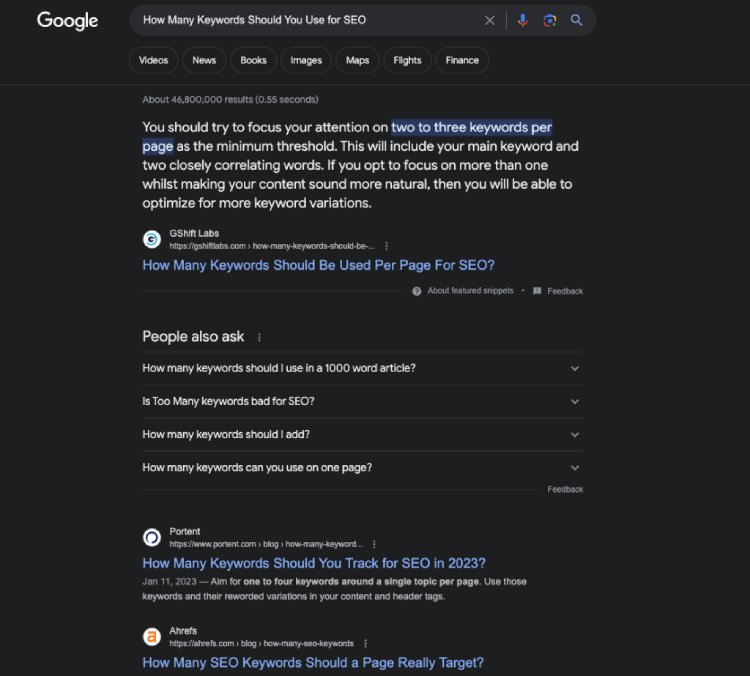
The simplest and most accessible method to check the competition to nail down the search intent is to take your primary keyword and pop it into Google. Now, check out those top-ranking pages and pay attention to a few key things:
- Dominating content type – Get a feel for what types of content are ruling the game. Popular formats like videos, articles, landing pages, and product pages are spotlighted.
- Dominating content format – Look closely at the content formats rocking the charts. You’ll see reviews, comparisons, listicles, how-to guides, and opinion-based articles stealing the show – that is generally evergreen content.
- Relevant content angles – Take note of the unique selling points showcased by those top-ranking pages. They might flaunt enticing angles like “best,” “free,” “all you need to know,” “in 2023,” and other attention-grabbing hooks.

You can make SERP analysis easier with tools like Ahrefs and gather valuable information about your competitors for a specific keyword. You can also see the length of their articles, assess the competition level on the SERP, check the number of backlinks they have, evaluate their domain rating, and more.
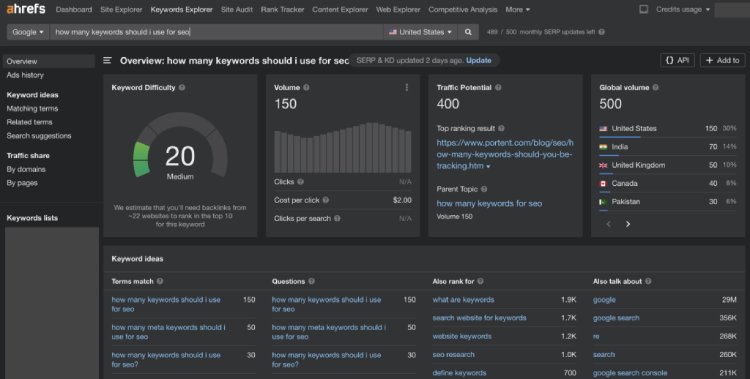
In simpler terms, this analysis helps you determine whether it’s worth creating a new article on a particular topic. Alternatively, if there is already an existing article, you can assess if it’s worth optimizing. If the competition is high and authoritative sites dominate the top rankings, reaching the first page might be challenging, but it’s not impossible.
While analyzing the SERP and the competition, you can also identify certain secondary keywords and subtopics that you can address in your article.
2. Optimize Your Content
Once you’ve compiled your list of keywords and subtopics, here are some valuable tips to enhance the optimization of your content pages using those targeted keywords:
Optimizing each page for a select few primary keywords is essential to maximize the impact of your SEO efforts. Limiting it to 1-2 primary keywords per page ensures your content remains focused and targeted.
When optimizing your content, strategically include your primary keyword in essential elements (title tags, meta tags, alt-image tags, H1 tags, some of the H2 tags, and URL) and secondary keywords in your subtopic titles (H2-H6).
However, exercising caution and avoiding excessive repetition (keyword stuffing) of your primary keyword is crucial. There’s no need to forcefully mention keywords multiple times or chase after a specific keyword density. Instead, focus on creating high-quality, valuable content that naturally incorporates relevant keywords to enhance its overall optimization.
Also, feel free to incorporate synonyms and variations of your keywords into your content, but don’t push inserting these synonyms or closely related keywords. Using more words to describe the same thing won’t automatically boost your content’s ranking.
Aim to maintain a maximum keyword repetition of 2-3 times per page, striking the right balance between optimization and natural flow.
Additionally, keep in mind that Google has a preference for long-form content. Long-form content tends to provide users with more comprehensive and detailed information, which aligns with Google’s goal of delivering valuable results.
Backlinko conducted a study that led them to a significant conclusion: long-form content yields better results than short-form content.
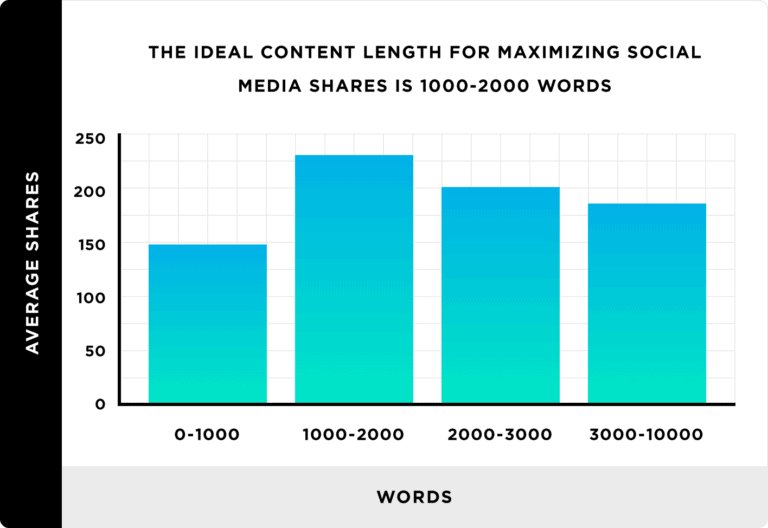
Source: Backlinko
As a general guideline, aim for around 1,500 words per page, which allows ample space to cover the topic thoroughly and engage your readers effectively.
Remember, quality should always take precedence over word count alone.
Final Take
So, until Google lays down the law and gives us a concrete answer about the precise number of keywords we should use, we’re left with relying on the experts and focusing on the tangible aspects we already know are crucial. That means creating high-quality, relevant, and user-focused content that hits the sweet spot.
Now, if you’re itching for a number, we have a recommendation. We suggest focusing 1-2 primary keywords and 2-3 secondary keywords in your content. This combo packs enough punch to land you that coveted first position in search results if you meet all the other criteria.
But don’t go overboard with those chosen keywords. We’re talking about avoiding the dreaded keyword stuffing at all costs. Keep it natural and classy, and let your content shine beyond just the keywords.
Remember, SEO is not a one-trick pony. It’s a multi-dimensional game. While keywords play a vital role, don’t neglect other aspects of your content. Improve it holistically, from engaging visuals to compelling storytelling and user-friendly experiences.